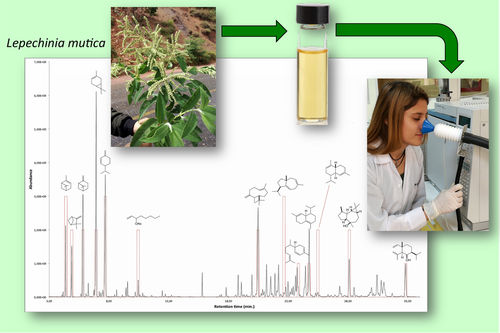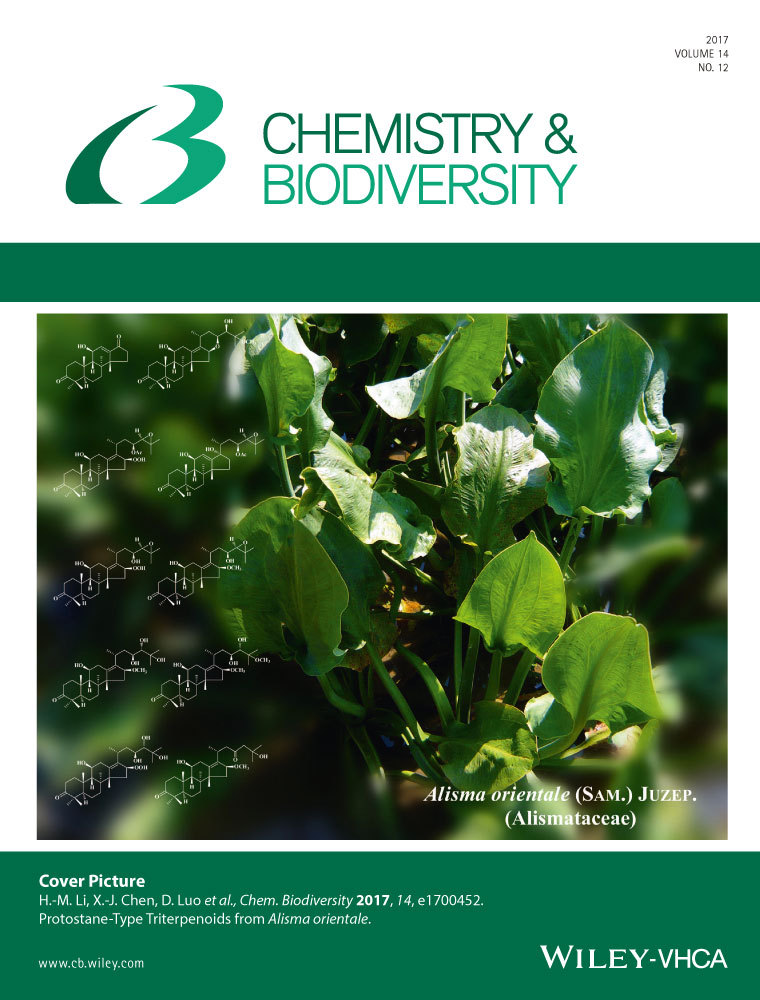Chemical Composition, Enantiomeric Analysis, AEDA Sensorial Evaluation and Antifungal Activity of the Essential Oil from the Ecuadorian Plant Lepechinia mutica Benth (Lamiaceae)
Jorge Ramírez
Departamento de Química y Ciencias Exactas, Universidad Técnica Particular de Loja, San Cayetano Alto s/n, Loja, Ecuador
Dipartimento di Chimica and CEMEC, Università degli Studi di Pavia, Viale Taramelli 12, 27100 Pavia, Italy
Search for more papers by this authorGianluca Gilardoni
Departamento de Química y Ciencias Exactas, Universidad Técnica Particular de Loja, San Cayetano Alto s/n, Loja, Ecuador
Search for more papers by this authorMiriam Jácome
Departamento de Química y Ciencias Exactas, Universidad Técnica Particular de Loja, San Cayetano Alto s/n, Loja, Ecuador
Search for more papers by this authorJosé Montesinos
Departamento de Química y Ciencias Exactas, Universidad Técnica Particular de Loja, San Cayetano Alto s/n, Loja, Ecuador
Search for more papers by this authorMarinella Rodolfi
Department of Earth and Environmental Sciences, Lab. Mycology, University of Pavia, Via San Epifanio 14, 27100 Pavia, Italy
Search for more papers by this authorMaria Lidia Guglielminetti
Department of Earth and Environmental Sciences, Lab. Mycology, University of Pavia, Via San Epifanio 14, 27100 Pavia, Italy
Search for more papers by this authorCecila Cagliero
Dipartimento di Scienza e Tecnologia del Farmaco, Università degli Studi di Torino, Via Pietro Giuria 9, 10125 Torino, Italy
Search for more papers by this authorCarlo Bicchi
Dipartimento di Scienza e Tecnologia del Farmaco, Università degli Studi di Torino, Via Pietro Giuria 9, 10125 Torino, Italy
Search for more papers by this authorGiovanni Vidari
Dipartimento di Chimica and CEMEC, Università degli Studi di Pavia, Viale Taramelli 12, 27100 Pavia, Italy
Search for more papers by this authorJorge Ramírez
Departamento de Química y Ciencias Exactas, Universidad Técnica Particular de Loja, San Cayetano Alto s/n, Loja, Ecuador
Dipartimento di Chimica and CEMEC, Università degli Studi di Pavia, Viale Taramelli 12, 27100 Pavia, Italy
Search for more papers by this authorGianluca Gilardoni
Departamento de Química y Ciencias Exactas, Universidad Técnica Particular de Loja, San Cayetano Alto s/n, Loja, Ecuador
Search for more papers by this authorMiriam Jácome
Departamento de Química y Ciencias Exactas, Universidad Técnica Particular de Loja, San Cayetano Alto s/n, Loja, Ecuador
Search for more papers by this authorJosé Montesinos
Departamento de Química y Ciencias Exactas, Universidad Técnica Particular de Loja, San Cayetano Alto s/n, Loja, Ecuador
Search for more papers by this authorMarinella Rodolfi
Department of Earth and Environmental Sciences, Lab. Mycology, University of Pavia, Via San Epifanio 14, 27100 Pavia, Italy
Search for more papers by this authorMaria Lidia Guglielminetti
Department of Earth and Environmental Sciences, Lab. Mycology, University of Pavia, Via San Epifanio 14, 27100 Pavia, Italy
Search for more papers by this authorCecila Cagliero
Dipartimento di Scienza e Tecnologia del Farmaco, Università degli Studi di Torino, Via Pietro Giuria 9, 10125 Torino, Italy
Search for more papers by this authorCarlo Bicchi
Dipartimento di Scienza e Tecnologia del Farmaco, Università degli Studi di Torino, Via Pietro Giuria 9, 10125 Torino, Italy
Search for more papers by this authorGiovanni Vidari
Dipartimento di Chimica and CEMEC, Università degli Studi di Pavia, Viale Taramelli 12, 27100 Pavia, Italy
Search for more papers by this authorAbstract
This study describes the GC-FID, GC/MS, GC-O, and enantioselective GC analysis of the essential oil hydrodistilled from leaves of Lepechinica mutica (Lamiaceae), collected in Ecuador. GC-FID and GC/MS analyses allowed the characterization and quantification of 79 components, representing 97.3% of the total sample. Sesquiterpene hydrocarbons (38.50%) and monoterpene hydrocarbons (30.59%) were found to be the most abundant volatiles, while oxygenated sesquiterpenes (16.20%) and oxygenated monoterpenes (2.10%) were the minor components. In order to better characterize the oil aroma, the most important odorants, from the sensorial point of view, were identified by Aroma Extract Dilution Analysis (AEDA) GC-O. They were α-Pinene, β-Phellandrene, and Dauca-5,8-diene, exhibiting the characteristic woody, herbaceus, and earthy odors, respectively. Enantioselective GC analysis of L. mutica essential oil revealed the presence of twelve couples and two enantiomerically pure chiral monoterpenoids. Their enantiomeric excesses were from a few percent units to 100%. Moreover, the essential oil exhibited moderate in vitro activity against five fungal strains, being especially effective against M. canis, which is a severe zoophilic dermatophyte causal agent of pet and human infections.
Graphical Abstract
Supporting Information
Supporting information for this article is available on the WWW under https://doi.org/10.1002/cbdv.201700292.
| Filename | Description |
|---|---|
| cbdv201700292-sup-0001-SupInfo.pdfPDF document, 275.9 KB |
Please note: The publisher is not responsible for the content or functionality of any supporting information supplied by the authors. Any queries (other than missing content) should be directed to the corresponding author for the article.
References
- 1R. Borges, L. B. Rojas, J. A. Cegarra, A. Usubillaga, ‘Study of the Essential Oils from the Leaves and Flowers of Lepechinia conferta (Benth) Epl’, Flavour Fragrance J. 2006, 21, 155 – 157.
- 2S. R. Fuselli, S. B. García de la Rosa, M. J. Eguaras, R. Fritz, ‘Susceptibility of the Honeybee Bacterial Pathogen Paenibacillus larvae to Essential Oils Distilled from Exotic and Indigenous Argentinean Plants’, J. Essent. Oil Res. 2008, 20, 464 – 470.
- 3J. B. Lopez Arze, G. Collin, F.-X. Garneau, F.-I. Jean, H. Gagnon, ‘Essential Oils from Bolivia. VI. Lamiaceae: Lepechinia graveolens (Reg.) Epling, L. floribunda (Benth.) Epling, and L. meyeni (Walp.) Epling’, J. Essent. Oil Res. 2009, 21, 36 – 40.
- 4M. C. Pellegrini, M. V. Alvarez, A. G. Ponce, N. M. Cugnata, F. G. De Piano, S. Fuselli, ‘Anti-Quorum Sensing and Antimicrobial Activity of Aromatic Species from South America’, J. Essent. Oil Res. 2014, 26, 458 – 465.
- 5A. Velasco-Negueruela, M. J. Pérez-Alonso, J. L. Esteban, C. A. Guzmán, J. A. Zygadlo, L. Ariza-Espinar, ‘Essential Oil of Lepechinia floribunda (Benth.) Epl’, J. Essent. Oil Res. 1994, 6, 539 – 540.
- 6J. G. Avila Acevedo, J. L. Muñoz Lóez, A. Martínez Cortés, A. M. García Bores, G. Martínez Cortés, I. Peñalosa Castro, ‘In Vitro Anti-Vibrio Cholerae Activity of Essential Oil from Lepechinia caulescens’, Fitoterapia 2005, 76, 104 – 107.
- 7E. Valarezo, A. Castillo, D. Guaya, V. Morocho, O. Malagón, ‘Chemical Composition of Essential Oils of Two Species of the Lamiaceae Family: Scutellaria volubilis and Lepechinia paniculata from Loja, Ecuador’, J. Essent. Oil Res. 2012, 24, 31 – 37.
- 8K. Caballero-Gallardo, J. Olivero-Verbel, E. E. Stashenko, ‘Repellent Activity of Essential Oils and Some of Their Individual Constituents against Tribolium castaneum Herbst’, J. Agric. Food Chem. 2011, 59, 1690 – 1696.
- 9G. Collin, F.-X. Garneau, H. Gagnon, A. Pichette, S. Lavoie, ‘Analysis of Cymenes in Essential Oils: The Case of Lepechinia meyeni (Walp.) Epling’, J. Essent. Oil Res. 2010, 22, 310 – 313.
- 10M. D. Eggers, G. Orsini, E. Stahl-Biskup, ‘Composition and Chemical Variation of the Essential Oil of Lepechinia salviaefolia (Kunth) Epl. from Venezuela’, J. Essent. Oil Res. 2001, 13, 1 – 4.
- 11M. D. Eggers, V. Sinnwell, E. Stahl-Biskup, ‘(–)-Spirolepechinene, A Spirosesquiterpene from Lepechinia bullata (Lamiaceae)’, Phytochemistry 1999, 51, 987 – 990.
- 12B. M. Lawrence, J. K. Morton, ‘Volatile Constituents of Lepechinia calycina’, Phytochemistry 1887, 1979, 18.
- 13E. E. Stashenko, M. Cervantes, Y. Combariza, H. Fuentes, J. R. Martínez, ‘HRGC/FID and HRGC/MSD Analysis of the Secondary Metabolites Obtained by Different Extraction Methods from Lepechinia schiedeana, and In Vitro Evaluation of its Antioxidant Activity’, J. High Resolut. Chromatogr. 1999, 22, 343 – 349.
10.1002/(SICI)1521-4168(19990601)22:6<343::AID-JHRC343>3.0.CO;2-J CAS Web of Science® Google Scholar
- 14M. Puertas-Mejía, S. Hillebrand, E. Stashenko, P. Winterhalter, ‘In Vitro Radical Scavenging Activity of Essential Oils from Columbian Plants and Fractions from Oregano (Origanum vulgare L.) Essential Oil’, Flavour Fragrance J. 2002, 17, 380 – 384.
- 15E. E. Stashenko, M. A. Puertas, J. R. Martínez, ‘SPME Determination of Volatile Aldehydes for Evaluation of In-Vitro Antioxidant Activity’, Anal. Bioanal. Chem. 2002, 373, 70 – 74.
- 16T. A. Zanoni, R. P. Adams, ‘Essential Oils of Plants from Hispaniola: 5. The Volatile Leaf Oil of Lepechinia urbanii (Briq.) Epling (Lamiaceae)’, Anal. Bioanal. Chem. 1991, 6, 75 – 77.
- 17L. Valenzuela, R. Vila, S. Cañigueral, T. Adzet, ‘The Essential Oil of Sphacele chamaedryoides’, Planta Med. 1992, 58, 273 – 274.
- 18V. Morocho, M. L. Toro, L. Cartuche, D. Guaya, E. Valarezo, O. Malagón, J. Ramírez, ‘Chemical Composition and Antimicrobial Activity of Essential Oil of Lepechinia radula Benth Epling’, Rec. Nat. Prod. 2017, 11, 57 – 62.
- 19O. Malagón, R. Vila, J. Iglesias, T. Zaragoza, S. Cañigueral, ‘Composition of the Essential Oils of Four Medicinal Plants from Ecuador’, Flavour Fragrance J. 2003, 18, 527 – 531.
- 20F. McLafferty, ‘ Registry of Mass Spectra Data’, Wiley, New York, NY, 1993.
- 21M. Brattoli, E. Cisternino, P. R. Dambruoso, G. de Gennaro, P. Giungato, A. Mazzone, J. Palmisani, M. Tutino, ‘Gas Chromatography Analysis with Olfactometric Detection (GC-O) As a Useful Methodology for Chemical Characterization of Odorous Compounds’, Sensors (Basel) 2013, 13, 16759 – 16800.
- 22W. Grosch, ‘Determination of Potent Odourants in Foods by Aroma Extract Dilution Analysis (AEDA) and Calculation of Odour Activity Values (OAVs)’, Flavour Fragrance J. 1994, 9, 147 – 158.
- 23W. Grosch, ‘Detection of Potemt Odorants in Foods by Aroma Extract Dilution Analysis’, Trends Food Sci. Technol. 1993, 4, 68 – 73.
- 24M. Benzo, G. Gilardoni, C. Gandini, G. Caccialanza, P. Vita Finzi, G. Vidari, S. Abd, P. Layedra, ‘Determination of the Threshold Odor Concentration of Main Odorants in Essential Oils Using Gas Chromatography – Olfactometry Incremental Dilution Technique’, J. Chromatogr. 2007, 1150, 131 – 135.
- 25W. A. König, D. H. Hochmuth, ‘Enantioselective Gas Chromatography in Flavor and Fragrance Analysis: Strategies for the Identification of Known and Unknown Plant Volatiles’, J. Chromatogr. Sci. 2004, 42, 423 – 439.
- 26P. Kreis, A. Mosandl, ‘Chiral Compounds of Essential Oils. Part XIII. Simultaneous Chirality Evaluation of Geranium Oil Constituents’, Flavour Fragrance J. 1993, 8, 161 – 168.
- 27R. P. Adams, ‘ Identification of Essential Oil Components by Gas Chromatography/Mass Spectrometry’, 4th edn, Allured Publishing Corporation, Carol Stream, IL, 2007.
- 28E. Liberto, C. Cagliero, B. Sgorbini, C. Bicchi, D. Sciarrone, B. D. Zellner, L. Mondello, P. Rubiolo, ‘Enantiomer Identification in the Flavour and Fragrance Fields by ‘Interactive’ Combination of Linear Retention Indices from Enantioselective Gas Chromatography and Mass Spectrometry’, J. Chromatogr. A 2008, 1195, 117 – 126.
- 29G. F. Suazo, F. M. González, A. P. Urbina, E. N. Pastene, K. C. Sáez, H. G. Serri, R. E. Chávez, ‘Actividad Insecticida del Aceite Esencial de Lepechinia chamaedryoides (Balb.) Epling en Drosophila melanogaster’, Gayana Bot. 2012, 69, 256 – 266.
- 30H. van Den Dool, P. D. Kratz, ‘A Generalization of the Retention Index System Including Linear Temperature Programmed. Gas-Liquid Partition Chromatography’, J. Chromatogr. 1963, 11, 463 – 471.
- 31G. Gadd, ‘ Toxicity Screening Using Fungi and Yeasts. Microbial Toxicity Testing’, Eds. B. Dutka, G. Bitton, CRC Press, Boca Raton, FL, 1986, p. 43 – 77.
- 32 CLSI, M27-A3, ‘ Reference Method for Broth Dilution Antifungal Susceptibility Testing of Yeasts: Approved Standard’, 3th edn, Clinical and Laboratory Standards Institute, Wayne, PA, 2008.
- 33 CLSI, M38-A2, ‘ Reference Method for Broth Dilution Antifungal Susceptibility Testing of Filamentous Fungi; Approved Standard’, 2nd edn, Clinical and Laboratory Standards Institute, Wayne, PA, 2008.





